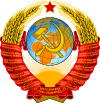This article needs additional citations for verification. (March 2019) |
| 1977 Constitution of the Soviet Union | |
|---|---|
 | |
| Supreme Soviet of the Soviet Union | |
| |
| Territorial extent | Soviet Union |
| Enacted by | Supreme Soviet of the Soviet Union |
| Signed by | Leonid Brezhnev |
| Effective | 7 October 1977 |
| Repealed | 26 December 1991 |
| Status: Repealed | |
The 1977 Constitution of the Soviet Union, officially the Constitution of the Union of Soviet Socialist Republics,[a] was adopted on 7 October 1977.
The 1977 Constitution, also known as the Brezhnev Constitution or the Constitution of Developed Socialism, was the third and final constitution of the Soviet Union, adopted unanimously at the 7th (Special) Session of the Ninth Convocation of the Supreme Soviet and signed by Chairman of the Presidium Leonid Brezhnev. The 1977 Constitution replaced the 1936 Constitution and the Soviet public holiday of USSR Constitution Day was shifted from 5 December to 7 October.[1][2]
The 1977 Constitution's preamble stated that "the aims of the dictatorship of the proletariat having been fulfilled, the Soviet state has become the state of the whole people" and no longer represented the workers and peasants alone. The 1977 Constitution extended the scope of the constitutional regulation of society compared to the 1924 and 1936 constitutions. The first chapter defined the leading role of the Communist Party of the Soviet Union (CPSU) and established the organizational principles for the state and the government. Article 1 defines the USSR as a socialist state, as did all previous constitutions:
The Union of Soviet Socialist Republics is a socialist state of the whole people, expressing the will and interests of the workers, peasants, and intelligentsia, the working people of all the nations and nationalities of the country.
The 1977 Constitution was long and detailed, including twenty-eight more articles than the 1936 Soviet Constitution and explicitly defined the division of responsibilities between the Central Government in Moscow and the governments of the republics. Later chapters established principles for economic management and cultural relations. The 1977 Constitution included Article 72, which granted the official right of constituent republics to secede from the Soviet Union promised in previous constitutions. However, Articles 74 and 75 stated that when a Soviet constituency introduced laws in contradiction to Supreme Soviet, the laws of the Supreme Soviet would supersede any legal difference, but the Union law which regulated the secession was not provided until the last days of the Soviet Union.[3]
Article 74. The laws of the USSR shall have the same force in all Union Republics. In the event of a discrepancy between a Union Republic law and an All-Union law, the law of the USSR shall prevail.
Article 75. The territory of the Union of Soviet Socialist Republics is a single entity and comprises the territories of the Union Republics. The sovereignty of the USSR extends throughout its territory.[4]
The 1977 Constitution was repealed upon the dissolution of the Soviet Union on 26 December 1991 and the post-Soviet states adopted new constitutions. Article 72 would play an important role in the dissolution despite the lacuna in the Soviet law, which was eventually filled under the pressure from the Republics in 1990.[3][5]
Cite error: There are <ref group=lower-alpha> tags or {{efn}} templates on this page, but the references will not show without a {{reflist|group=lower-alpha}} template or {{notelist}} template (see the help page).
- ^ Unger, Aryeh L. (1981-01-01). Constitutional Development in the USSR: A Guide to the Soviet Constitutions. Methuen. p. 197. ISBN 978-0-416-71680-1.
- ^ Smorodinskaya (2013-10-28). Encyclopedia of Contemporary Russian Culture. Routledge. p. 250. ISBN 978-1-136-78785-0.
- ^ a b [1] by Paul Fisher, The Washington Post, 2016
- ^ [2] Full Text of the 1977 Soviet Union Constitution
- ^ Law on Secession from the USSR (Original Source: Ведомости Съезда народных депутатов СССР и Верховного Совета СССР, 1990, № 15, ст. 252)